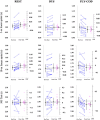Effects of Different Post Warm-Up Strategies for Non-Starter Players in Futsal
- PMID: 40463321
- PMCID: PMC12127939
- DOI: 10.5114/jhk/192789
Effects of Different Post Warm-Up Strategies for Non-Starter Players in Futsal
Abstract
Futsal warm-ups are crucial pre-match routines designed to enhance players' readiness. However, non-starter players inevitably face longer periods of inactivity. This study aimed to investigate the effects of various post warm-up strategies on physical performance of non-starter players in futsal. Thirteen highly trained male futsal players participated in this study during the in-season period. All players performed three distinct post warm-up strategies over consecutive days: REST, dynamic stretching (DYS), and a combination of plyometrics with change of direction drills (PLY-COD). After performing a standard warm-up, players remained inactive for 10 min, mirroring the traditional time window leading up to the start of the match. Subsequently, post warm-up strategies were implemented. Testing included a countermovement-jump, a reactive strength index, 5- and 10-m sprints, and a 505 COD test. Players were tested 10 min after the conclusion of the warm-up and immediately after the post warm-up strategy. The PLY-COD strategy yielded positive effects across all variables. Running performance improved with small to moderate effect in both sprint (-2.2 ± 1.9%), (-1.6 ± 1.7%), and COD (-2.9 ± 3.5%) tests. Conversely, both DYS and REST strategies had a detrimental impact on running and jumping performances, with this impairment being more pronounced in running following REST strategy, particularly in the 10-m linear sprint (1.4 ± 1.7%). These results suggest that remaining inactive or exerting limited effort after a warm-up may be detrimental to physical performance of futsal non-starter players. On the other hand, PLY-COD drills could be effective strategies to maintain or even enhance physical performance following the warm-up.
Keywords: jumping; potentiation; running.
Copyright: © Academy of Physical Education in Katowice.
Conflict of interest statement
The authors declare no conflict of interest.
Figures




Similar articles
-
Pre-match Warm-Up Dynamics and Workload in Elite Futsal.Front Psychol. 2020 Nov 26;11:584602. doi: 10.3389/fpsyg.2020.584602. eCollection 2020. Front Psychol. 2020. PMID: 33324293 Free PMC article.
-
Seasonal Changes in the Physical Performance of Elite Youth Female Soccer Players.J Strength Cond Res. 2020 Sep;34(9):2636-2643. doi: 10.1519/JSC.0000000000002943. J Strength Cond Res. 2020. PMID: 30358700
-
Effects of acute caffeine ingestion on futsal performance in sub-elite players.Eur J Nutr. 2021 Dec;60(8):4531-4540. doi: 10.1007/s00394-021-02617-w. Epub 2021 Jun 16. Eur J Nutr. 2021. PMID: 34132880 Clinical Trial.
-
Effects of Warm-Up, Post-Warm-Up, and Re-Warm-Up Strategies on Explosive Efforts in Team Sports: A Systematic Review.Sports Med. 2018 Oct;48(10):2285-2299. doi: 10.1007/s40279-018-0958-5. Sports Med. 2018. PMID: 29968230
-
Physical and Physiological Match-Play Demands and Player Characteristics in Futsal: A Systematic Review.Front Psychol. 2020 Nov 6;11:569897. doi: 10.3389/fpsyg.2020.569897. eCollection 2020. Front Psychol. 2020. PMID: 33240157 Free PMC article. Review.
References
-
- Alberti, G., Annoni, M., Ongaro, L., Scurati, R., & Michielon, G. (2014). Athletic Performance Decreases in Young Basketball Players after Sitting. International Journal of Sports Science & Coaching, 9(5), 975–984. 10.1260/1747-9541.9.5.975 - DOI
-
- Andrade, D. C., Henriquez-Olguin, C., Beltran, A. R., Ramirez, M. A., Labarca, C., Cornejo, M., Alvarez, C., & Ramirez-Campillo, R. (2015). Effects of general, specific and combined warm-up on explosive muscular performance. Biology of Sport, 32(2), 123–128. 10.5604/20831862.1140426 - DOI - PMC - PubMed
-
- Blazevich, A. J., Gill, N. D., Kvorning, T., Kay, A. D., Goh, A. G., Hilton, B., Drinkwater, E. J., & Behm, D. G. (2018). No Effect of Muscle Stretching within a Full, Dynamic Warm-up on Athletic Performance. Medicine & Science in Sports & Exercise, 50(6), 1258–1266. 10.1249/MSS.0000000000001539 - DOI - PubMed
-
- Bosco, C., Luhtanen, P., & Komi, P. V. (1983). A simple method for measurement of mechanical power in jumping. European Journal of Applied Physiology Occupational Physiology, 50(2), 273–282. http://www.ncbi.nlm.nih.gov/pubmed/6681758 - PubMed
LinkOut - more resources
Full Text Sources
